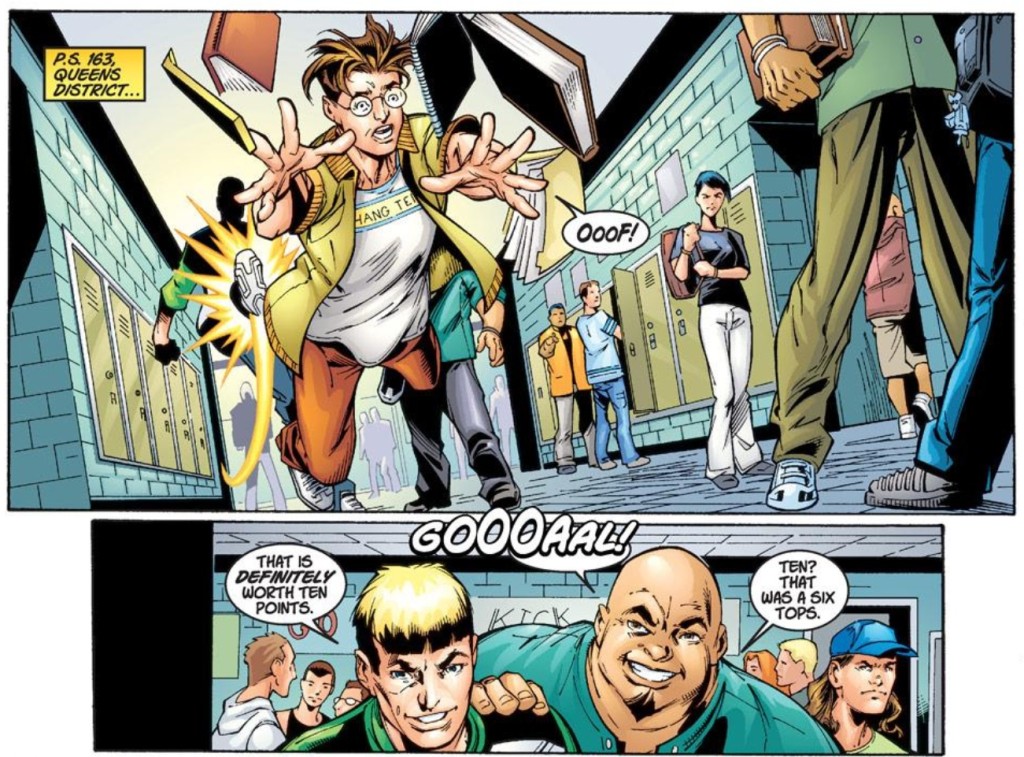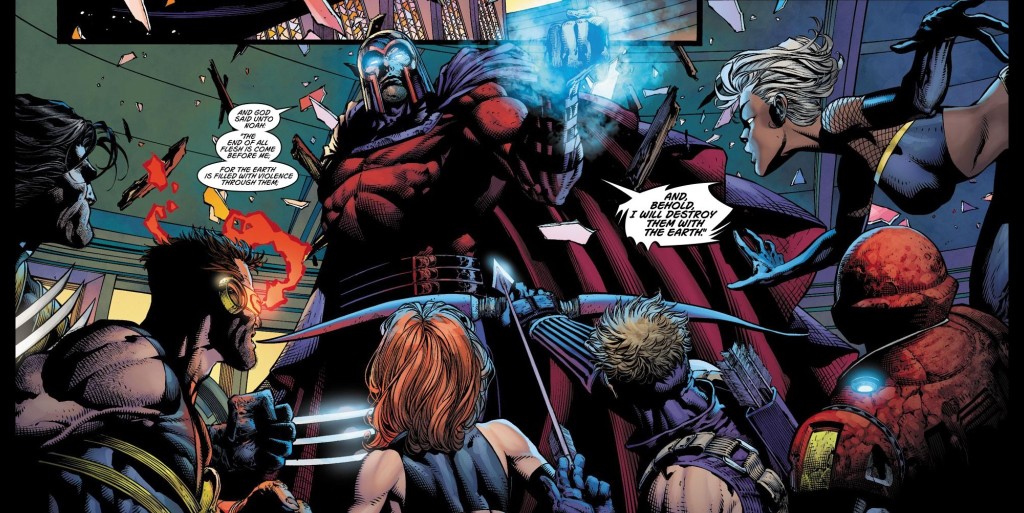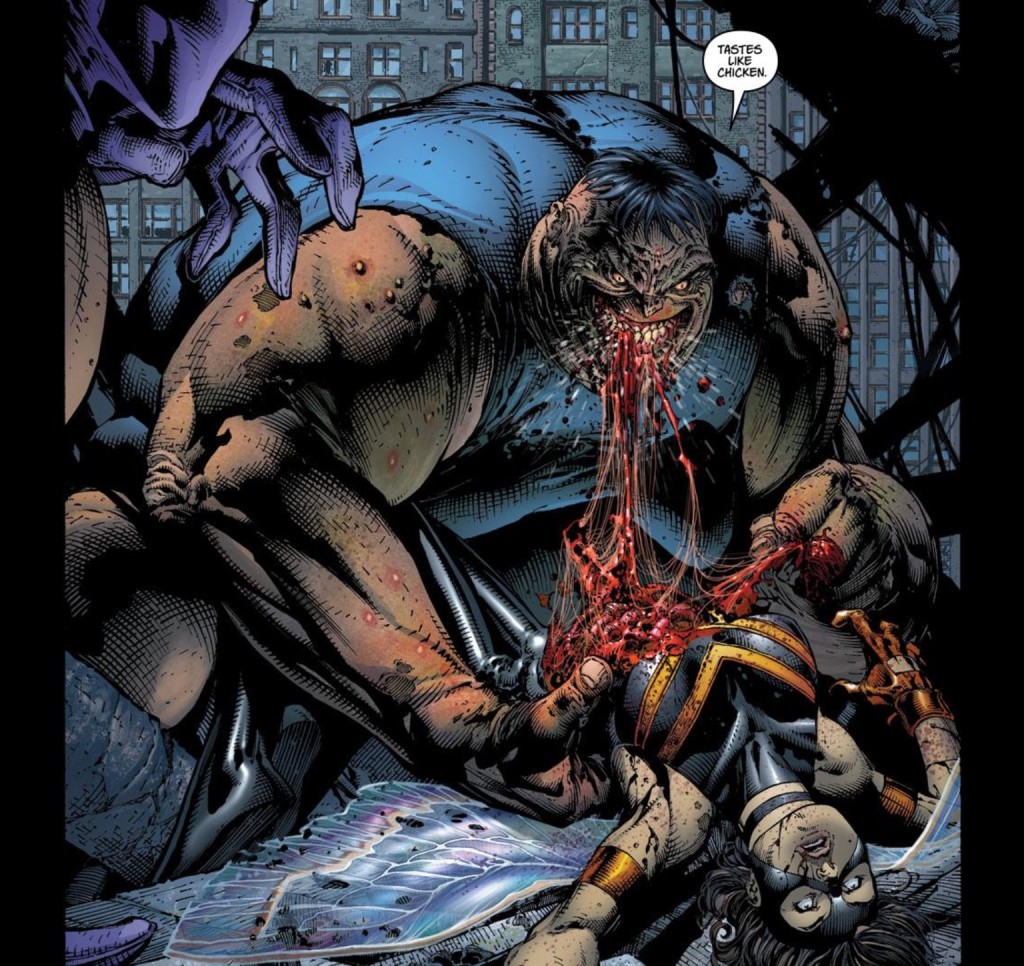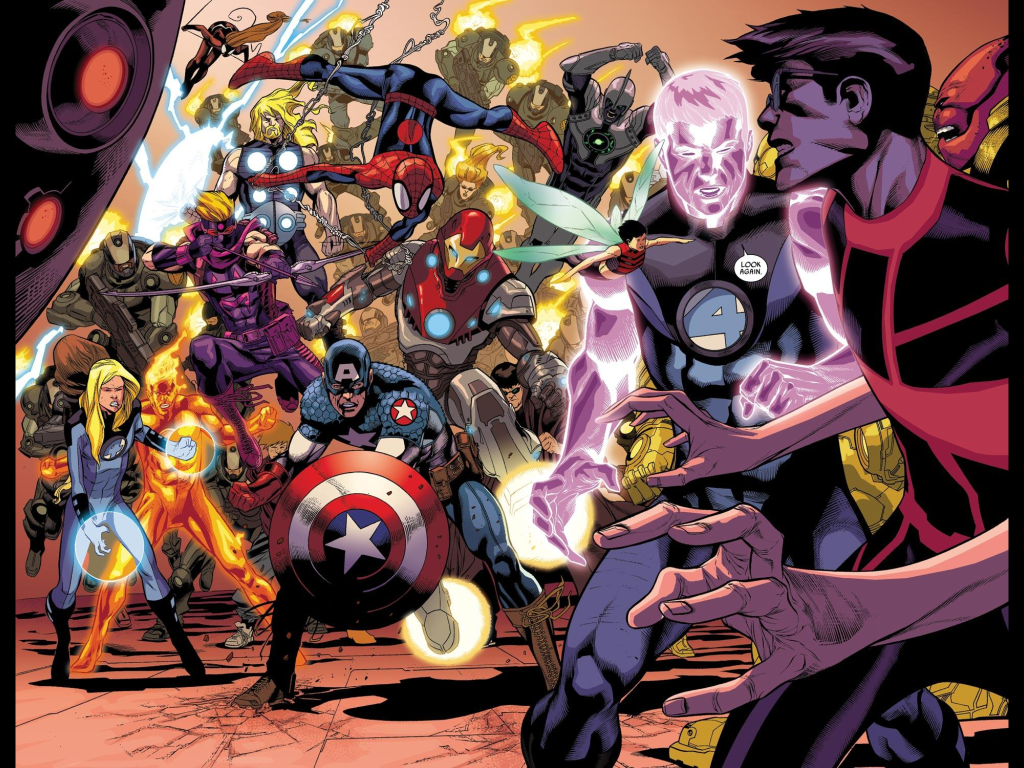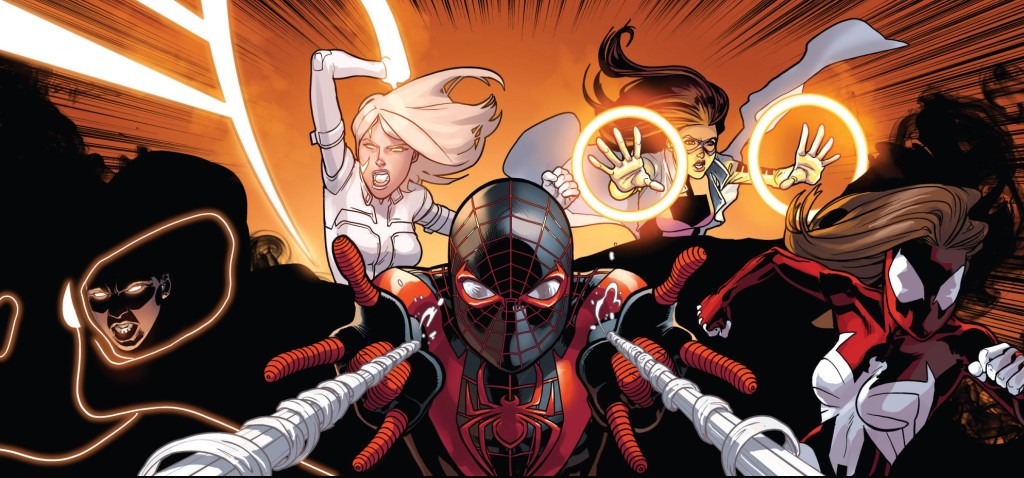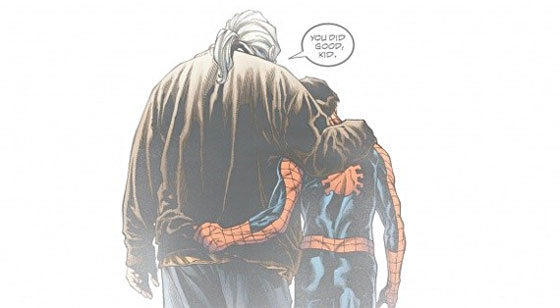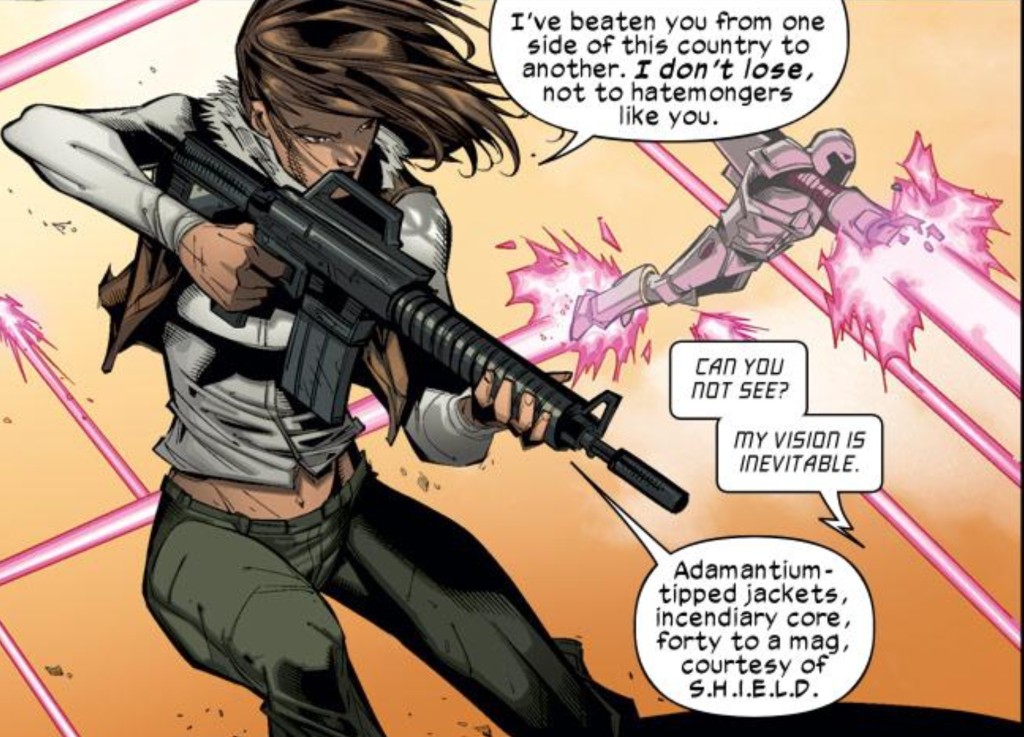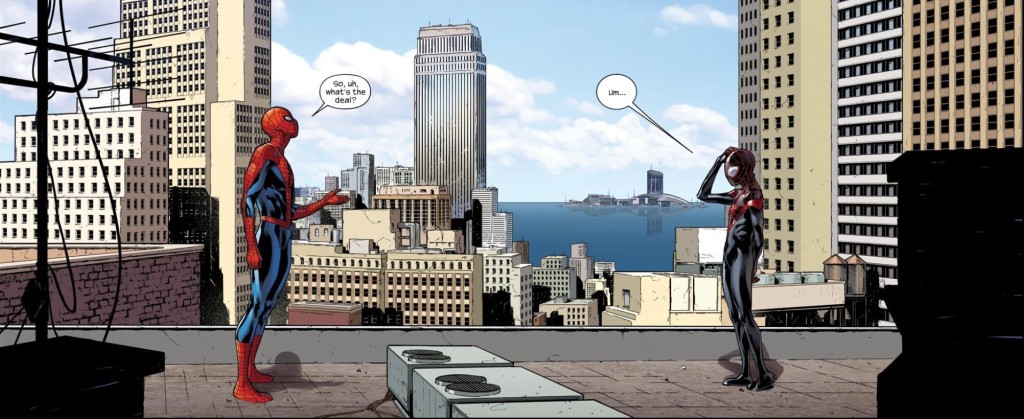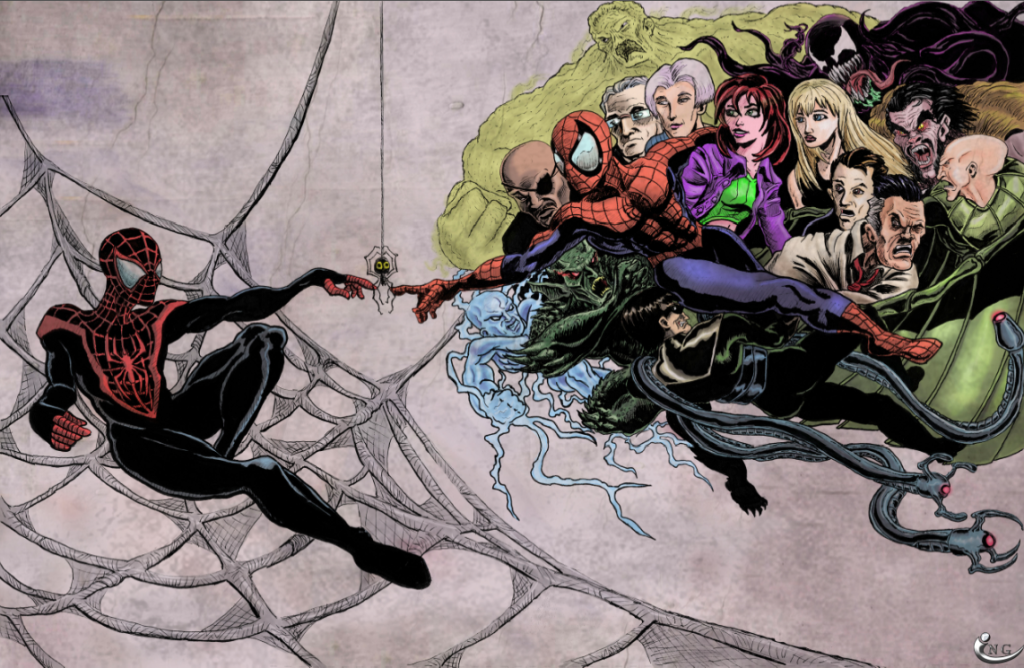
Original artwork for this article by Ing.
Two mighty forces ensure the immortality of superhero characters. On the one hand, you have the massive corporations who own the characters, who profit from keeping them alive, successful and popular, but frequently misinterpret the appeal of the characters. On the other, you have comics fans, who keep the money coming in and take their own sort of ownership over the characters, claiming greater knowledge and understanding of what makes them special, but who are often impossible to please. Both forces have an enormous stake in the characters, whether that stake is financial or emotional, and want what’s best for them and their stories (though their ideas of what’s best frequently clash).
Ultimately, both forces oppose change above all else.
What results is a cyclical storytelling structure, where characters and their worlds evolve and change, stretching further from their established rules and limitations, only to eventually snap back to the status quo. Witnessing this over and over leads to the inevitable conclusion that all superhero comics fans eventually reach: There are no consequences to superhero stories. There is only the illusion of consequences.
Of course, all of the above applies primarily to superhero comics published by DC and Marvel Comics, and there are superhero stories created by other companies who don’t follow this model. There are other places you can, and probably should, go (I highly recommend Powers by Brian Michael Bendis and Michael Avon Oeming). But let’s also be honest – you’d like to read stories that feature those icons you grew up with, while still feeling some sense that in five years, you’ll have some reason to remember the events of the book you’re reading today, because it’ll still matter to the story.
The solution to this problem is called Ultimate Marvel.
ONE – Foresight and First Impressions
The turn of the century saw Marvel Comics limping out of bankruptcy, in desperate need of a major shakeup. New company president Bill Jemas and future Editor-In-Chief Joe Quesada, looking for a way to use the momentum from the success of the first X-Men film and the buzz for the upcoming Spider-Man, devised a plan to launch a new version of the Marvel Universe that would be free from the superhero line’s half-century of continuity. By starting from scratch with a new line of books tailored to a more modern sensibility, Jemas and Quesada hoped to attract a fresh young readership and revitalize the publisher.
Thing is, this wouldn’t be the first time Marvel had tried to attract new readers by starting from scratch. In 1996 and 1997, the publisher handed the keys to the Avengers and Fantastic Four to Jim Lee and Rob Leifeld’s studios to re-imagine in Heroes Reborn, and the following year John Byrne gave it a go with Spider-Man: Chapter One, but neither effort produced any long-lasting change for Marvel, the company or the comics universe. This attempt would have to be different – rather than revising the existing continuity, which frustrates and confuses readers, a new line of books would be launched alongside the existing one, with the bold title of Ultimate Marvel.
Ultimate Marvel would endeavor to be just that – to take all the stories that had existed before in the Marvel Universe and filter it through only a handful of creative minds to create a singular vision, starting the story of each character over from the beginning but with all of the hindsight (or foresight, depending on your perspective) about where these characters’ stories were headed. It was an opportunity to revisit old stories in new ways, to selectively expand and contract the mythology, firm up the foundations and build to new heights. It’s essentially the precursor to the franchise re-imagining trend that’s ruled Hollywood (for better or worse) since the turn of the century. Your parents’ generation had their Spider-Man, now you have yours; it was made specifically for you and it starts right here and right now. Here’s volume one, issue one, no previous experience required.
Like any other remake or re-imagining, it wouldn’t be enough just to move the story into a contemporary setting – the new version would have to acknowledge the way the world itself has changed since the original was made. The essence of why it worked, particularly in the case of Ultimate Spider-Man, was best summed up by Joe Quesada in an interview he did with Comic Book Resources back in 2008:
“Brian [Michael Bendis] took the idea of Peter Parker as the skinny guy, pocket protector, nerd with the horn rimmed glasses — which is what the nerdy kid was like in that era – and he looked at today’s modern world and Peter Parker dropped all those trappings and became more of a very brooding sort of kid. He had a sort of intensity to him — he’d either end up being one of two things: he’d either be a nerd or the guy who shows up at the high school the next day in a trench coat and blows everybody away. That was the shift that was needed. It wasn’t about computers or microscopes or cell phones. It was about an emotional difference between what the kid is today compared to what he would have been in the ‘60s.”
The Peter Parker who came of age in the 1960s was an outcast because of his intellect. The Peter Parker who came of age in the 2000s was stressed out of his goddamn mind from academic pressure. The Avengers fought supervillains. The Ultimates fought terrorism.
Even more than in the existing Marvel Universe, (referred to in-house and by fans as Earth-616,) Ultimate Marvel (Earth-1610) would feel like one cohesive world explored across multiple titles. Unlike the mainstream universe, which had to build its mythology as it went along, Ultimate Marvel had a fully realized blueprint for what the big picture of the universe might look like, and could build all of its characters’ origins to trace back to one common origin point. The Hulk, Spider-Man, even the X-Men, as readers would learn years later, would all be the result of attempts to recreate the Super-Soldier Serum that made Captain America back in World War II. The race to make the next genetically superior soldier, whether for political or financial gain, became the driving force behind the over-arching mythology of the Ultimate Marvel universe.
Each series, whether it was initially apparent or not, was a different perspective on that cold war. Ultimate Spider-Man was about a high school kid who got accidentally transformed into a superhuman, which makes him a target for criminals, corporations and governments who want to dissect him and figure out how it do it again. Ultimate X-Men was about the struggle to control the destiny of a whole race of people who, it would be revealed years later, was an unintended result of super-soldier experiments. The Ultimates explored the enormous geopolitical repercussions of a world where nations employ armies of superhumans, making conventional military powers all but obsolete. Even Ultimate Fantastic Four, whose adventures mostly took place apart from the rest, began with a government-sponsored think tank of juvenile super-geniuses performing wild experiments for the benefit of their country, just another branch of the race for military dominance.
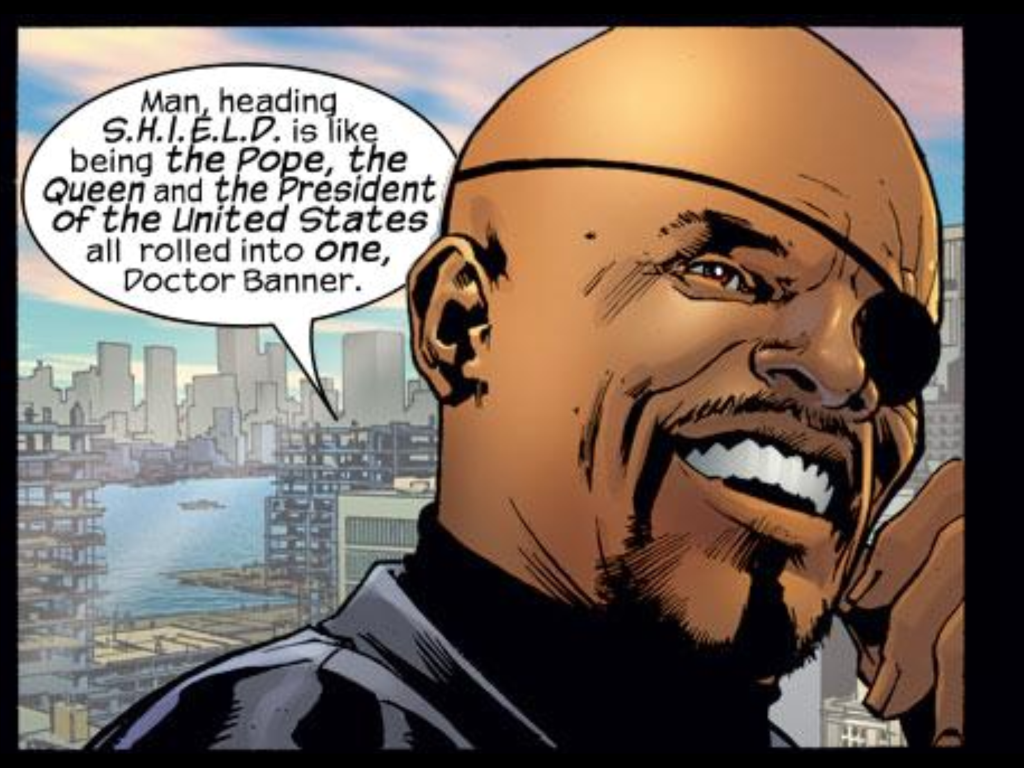
Mark Millar and Bryan Hitch famously “cast” Samuel L. Jackson as Nick Fury in The Ultimates, forecasting his eventual big-screen role. Art by Bryan Hitch, from The Ultimates v.1 #2.
And presiding over it all, S.H.I.E.L.D. director Nick Fury, who appeared in each book to bind it all together. The man responsible for making and enforcing law over the superpowered world, Fury could seem a hero in one book and a shadowy villain in another, all while maintaining fairly consistent characterization. In the cynical and conservative Ultimates, Fury is the one man willing to do whatever it takes to protect humanity. Meanwhile in Ultimate Spider-Man, Fury represents a frightening future for Peter – conscription into the military, becoming a tool for the government whether he wants to or not. Nick Fury personifies both the connection and the variety found in the Ultimate Marvel universe and does so throughout the line’s entire history.
The Ultimate Marvel line proved to be a critical and commercial success for the publisher. But over time, what began as a cohesive, thematically-linked universe guided by only a few choice creators began to slip into some of the same problems faced by the mainstream Marvel line. Books changed hands between creative teams more often, leading to less consistent characterization and more wild tonal shifts. Earth-1610 was looking more and more like Earth-616, and losing some of its luster along the way.
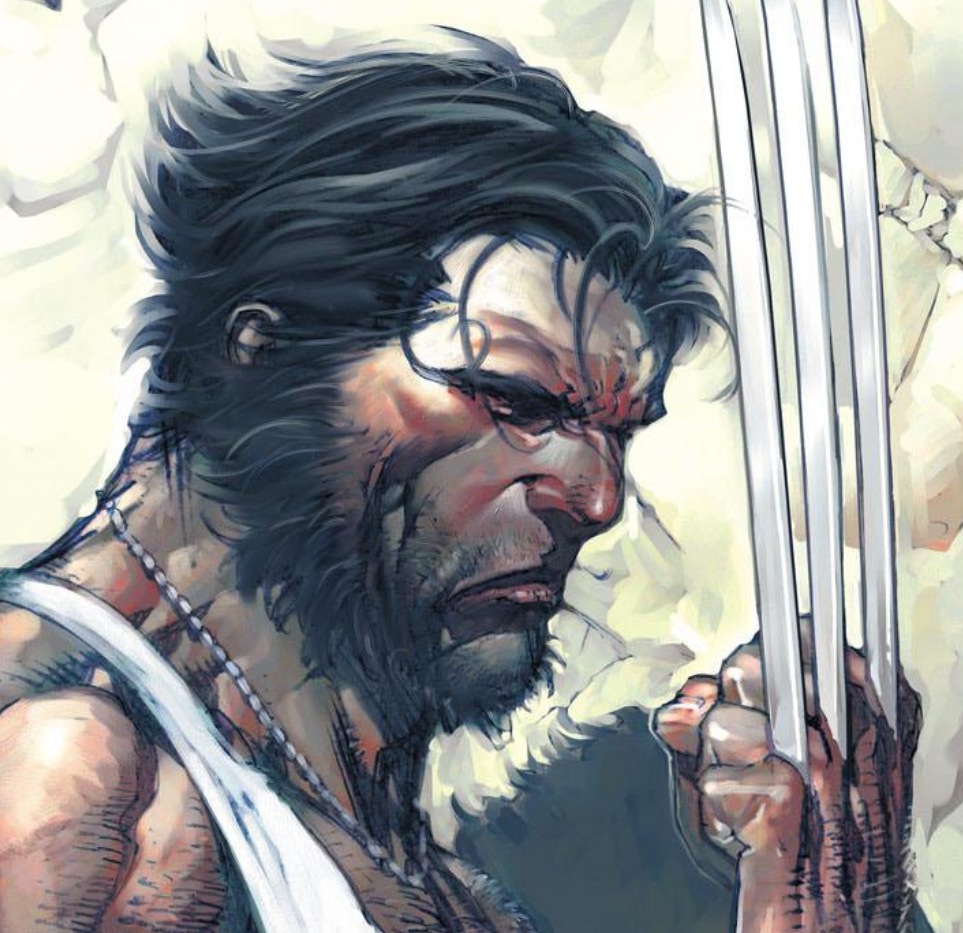
Superficial as it may seem, it was a bad sign when Ultimate Wolverine lost his goatee and started looking exactly like his 616 counterpart. Art by David Finch, from the cover of Ultimate X-Men v.1 #35.
By 2008, it was time for a major shake-up for the Ultimate Marvel line. It would come in the form of one truly awful miniseries: Ultimatum.
TWO – Doubling Down on the Worst Comic Ever (and Winning)
Even if you’ve never read Jeph Loeb & David Finch’s Ultimatum, the line-wide crossover event that capped off the first sequence of Ultimate Marvel, you’re probably aware of its notorious reputation. Whether or not that superlative is deserved is up for debate, but make no mistake, Ultimatum is a lousy comics story from beginning to end, being both ill-conceived and poorly executed.
The plot of the miniseries is infamous – Magneto, grief-stricken after the apparent deaths of his children, hits New York with a giant tidal wave that results in the sudden, impactless deaths of several members of the X-Men and The Ultimates, along with thousands of New Yorkers. The surviving heroes deal with the aftermath and take the fight to Magneto, as even more characters die in gruesome but emotionally meaningless fashion. It’s five issues of non-stop blood, misery, and death, and it relishes in every pointless, incompetent moment.
This is a story in which a giant wave drowns Manhattan and you never actually see the wave. You see the flood, but the obvious, terrifying image of a thousand-story tsunami looming over the New York skyline isn’t seen until a flashback in Cataclysm: Ultimate Spider-Man five years later. The bodies of Beast, Nightcrawler, Dazzler, and Daredevil are discovered, but their deaths occur off panel.
In the perhaps the most infamous panel in the history of Ultimate Marvel, Janet Van Dyne, The Wasp, is torn in half and partially eaten by the Blob. Aside from one panel of dialogue at the very beginning, this is her first appearance in the story.
Dr. Strange’s head explodes. Professor X gets his neck snapped. Wolverine is incinerated. Magneto and Dr. Doom are executed. And when it seems like the dust has finally settled, Cyclops is shot dead on the steps of the Capitol… by Quicksilver, whose “death” set the whole bloody affair into motion. Despite the high stakes, there’s barely a modicum of gravity to any of Ultimatum‘s gruesome moments. It’s contrived, shocking-for-shocking’s-sake death porn. It is the perfect example of every criticism readers make of crossover events.
But here’s the thing: none of it’s been undone. It’s been six years since Ultimatum and all those casualties listed above are still dead. The culture and politics of Earth-1610 are still colored by the flooding of New York. Instead of burying the story and undoing its unpopular consequences, the event is referenced frequently as a pivotal moment in history (Cataclysm: Ultimate Spider-Man recently revisited the flooding of New York and in genuinely compelling and emotional story). Marvel made this offensive, unfathomably bad comics story and they actually don’t want you to forget about it. Instead, they ran with it, embracing the loss of the staple Marvel characters and bringing in a string of new characters, allowing the Ultimate Universe to take on more of its own identity. The cast shake-up sent the relaunched Ultimate Marvel books in new, unexplored directions.
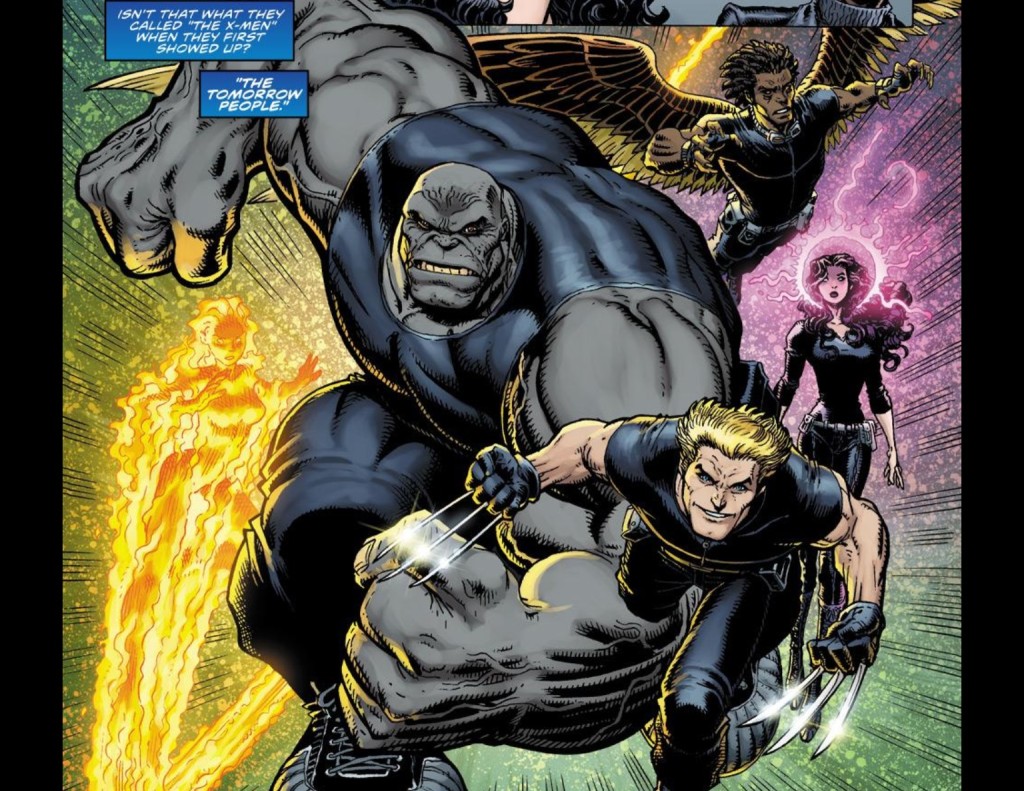
Liz Allen, Hulk, Derek Morgan, Karen Grant and Jimmy Hudson in Ultimate Comics: X #5. (Art by Art Adams.)
That’s not to say that all of these new directions yielded great results. Jeph Loeb’s Ultimate Comics: New Ultimates was hardly more mature than Ultimatum and felt like it could have easily existed in the mainstream Marvel U. Mark Millar’s uneven Ultimate Avengers trilogy featured so many characters powered by the super-soldier serum that it undercut the entire “genetic cold war” angle that fueled the line’s ongoing mytharc. Ultimate Comics X, which followed the aftermath of a major change to X-Men mythology, went in some interesting directions like introducing Wolverine’s estranged son but artist Art Adams’ depiction of Jean Grey (now going by the moniker Karen Grant) is so hypersexualized that the book becomes uncomfortable to read. But false starts aside, it was a start to building Ultimate Marvel into that fabled World of Consequences.
Ultimate Fantastic Four ended for good after Ultimatum, with the team split up and appearing in other books, but a trio of miniseries by writer Brian Michael Bendis and artist Rafa Sondoval, together titled Ultimate Comics: Doomsday, brought them together with members of the Spider-Man and Ultimates casts to tell a story that would, once again, have lasting consequences, outing Reed “Mr. Fantastic” Richards as the man responsible for a string of mass murders. Were such a major character twist made on Earth-616, it would never stick, but in Ultimate Marvel it’s irreversible. The events of Doomsday sent Reed down an entirely new path that’s totally unique from his mainstream counterpart.
As always, Brian Michael Bendis’s Spider-Man remained the strongest link in the Ultimate Marvel chain, adding the Human Torch and Iceman to the regular cast, looking to capture the feeling of the classic Spider-Man and his Amazing Friends cartoon. (Bendis admits that he spent years trying to make this exact thing happen). In stark contrast to the dark tone found in most Ultimate books, Ultimate Comics: Spider-Man stayed fairly light and friendly to young readers. Even fans who had given up on the rest of the line after Ultimatum were still holding on with Spidey.
So it took a special kind of guile to then turn around and kill Peter Parker.
THREE – Miles Morales and The Cool
Ultimatum had showed that the minds behind Ultimate Marvel were dead serious about death meaning something on Earth-1610. In the decade since the launch of the line, nearly every character who had been killed off had stayed dead, including heavy hitters like Wolverine and Black Widow (exceptions include Gwen Stacy, who basically got cloned, Quicksilver, whose death was apparently faked but never explained, and Beast, who died again anyway and stayed that way). The gravity and finality of death that was lacking in the traditional Marvel Universe had been well established, but Ultimate Marvel had yet to provide a major character with an ending that felt earned or in any way satisfying.
“The Death of Spider-Man” story was a very daring, very public declaration that this was about to change. Original Ultimate Spider-Man artist Mark Bagley reunited with writer Brian Michael Bendis, who at this point had been the book’s sole writer for over 150 issues, to tell the final story of Earth-1610’s Peter Parker. Where previous major Ultimate Universe deaths had been sudden and bereft in feeling, Peter’s would be an event, a milestone so important that the entire Ultimate line would stop, take notice, and then begin again with new volumes and new #1s.
“The Death of Spider-Man” was a five-issue story, followed by a six-issue Ultimate Fallout miniseries that would deal with the impact of his death on the line’s entire cast of characters, as well as setting the stage for the next wave of Ultimate books. As a story in itself, “The Death of Spider-Man” accomplishes a lot, wrapping up long-running character threads and providing Peter with a hero’s death and a bittersweet final moment with his loved ones. But Parker’s death also marked an important turning point for Ultimate Marvel, the commitment to an idea that had begun with Ultimatum but not yet truly found expression.
Where Ultimate Marvel had begun as a way to retell and reexamine baggage-free versions of classic tales about recognizable characters, its nature had changed dramatically. It no longer functioned as a more accessible, condensed version of the traditional Marvel Universe, and as long as it continued to avoid returning to status quo like its counterpart, it never would never again serve that purpose. With “The Death of Spider-Man”, and the subsequent relaunch of the line, the minds behind Ultimate Marvel finally threw their hats over the wall. Their new mission, a expressed by writer Jonathan Hickman in the letters page in Ultimate Comics: Ultimates #1: “Do things we can’t do in the 616.”
This began with paying off some of the world-shaking promises made in previous years but never paid off. The Ultimate Doomsday miniseries turned the Fantastic Four’s Reed Richards from hero to villain, but now in Ultimate Comics: Ultimates he’d get to make good on his threats. Even before that, back in Ultimate Origins, the key twist that this universe’s mutants were not the next course of human evolution but an out-of-control experiment of the US Government had been revealed, but the information was still a secret even to most Mutant characters. Now, in Ultimate Comics: X-Men, the secret would be revealed to the whole world, and the entire nature of the X-Men would have to change.
And finally, the most crucial and dramatic new feature of Ultimate Marvel: Miles Morales, a half-Black, half-Hispanic, thirteen-year-old kid from Brooklyn, would now carry on the mantle of Spider-Man. This embodies the quest of this last cycle of Ultimate Marvel books – you’re not going to mistake Miles Morales for Peter Parker, and likewise, you’re not going to open any Ultimate book and mistake it for a mainstream Marvel title.
Miles Morales has breathed new life into the Ultimate Marvel universe. Grabbing attention from new and old readers who were excited to see new ideas and better representation in mainstream comics, or maybe just looking for a clear jumping-on point for a new book, creators Brian Michael Bendis and Sara Pichelli have succeeding in creating a new superhero who is instantly likeable and has enjoyed lasting appeal. Now, rather than being a place where alternate versions of old favorite characters can play out new stories, now the Ultimate U is the home of your new favorite character.
The all-new Ultimate Comics: Spider-Man series was an accessible jumping on point for new readers and, in the tradition of its predecessors, has remained completely self-contained. The rest of the line, however, has become more closely connected than ever. Between Ultimates, X-Men, and a Hawkeye miniseries, a massive story has unfolded that has seen entire nations collapse and new ones rise in their place. The line-wide crossover Divided We Fall/United We Stand puts the United States through an honest-to-God civil war. In the aftermath, the few remaining Mutants, led by a hardened, machine-gun-toting Kitty Pryde, have their own sovereign nation in the Southwest and Captain America is the President of the United States.
This most recent cycle of Ultimate Marvel has also began finally breaking down the walls between Earth-1610 and the mainstream Earth-616, celebrating the 50th anniversary of Spider-Man’s first appearance with the miniseries Spider-Men, allowing the classic Peter Parker Spidey to meet his alternate universe successor Miles Morales for the first time. This five-issue story highlighted how different the new universe had become from its predecessor, but also how the spirit of Spider-Man was alive and well in Miles. Ultimate Peter Parker’s death meant there was no way to properly pass the torch – now Miles could have the blessing of the original wall-crawler.
Later, the mainstream universe’s Galactus would break into the Ultimate universe to reak havoc, bringing about more drastic change for the line. Like Ultimatum before it, Cataclysm: The Ultimates’ Last Stand would be a crossover event preceding another line-wide relaunch, and would again spell death, destruction, and major changes to the nature of the 1610. New Jersey is demolished, Captain America and Thor are lost and S.H.I.E.L.D. is no more, but the younger generation is prepared to step up and fill their shoes.
Now Ultimate Marvel is about to begin its fourth cycle, complete with three new ongoing series and a setting that’s never been further from its starting point as a condensed, streamlined version of the original Marvel Universe. Miles Morales: Ultimate Spider-Man will follow the continuing adventures of the popular original character. All-New Ultimates stars Spider-Man, Kitty Pryde, Cloak & Dagger, Bombshell and Jessica Drew, who’s taken up the mantle of the Black Widow. Finally, Ultimate FF will center around supergeniuses Susan Storm and Tony Stark as they try to make sense of the new, post-Galactus world and build a better future.
This relaunch, billed as Ultimate Marvel NOW, is meant to be an accessible jumping-on point for new readers, but everything that’s happened over the past decade at Ultimate Marvel has led to this point. These are new stories featuring fresh characters, and it’s all built on a rich history. The changes that have been made to the Ultimate Marvel Universe, and the creators’ commitment to those changes even when they’re drastic or unpopular, has led to a uniquely exciting world where anything can happen, and everything has a lasting impact.
Ing is a self-taught artist in the New Jersey-Pennsylvania-New York Tristate area. Inspirations vary widely from sci-fi and fantasy art to surrealism and literature. For commisions or other drawing requests, contact him through his website.


